Introduction
Sources of contaminants for freshwater include direct and via runoff, direct discharges into water or watersheds, atmospheric deposition as well as wastes from settlements. Accumulation of heavy metals in aquatic environments can cause accumulation in living organisms which may pose risks to human health via food.1 Concentration of a contaminant in aquatic organisms is a good indicator of the contaminant’s bioavailability.2 Fish are incessantly exposed to contaminants released into water bodies. In general fish species as the top of the aquatic food chains may accumulate huge amounts of contaminants especially heavy metals from the water bodies and have accordingly been found to be a good bio-indicator of heavy metal contamination in aquatic systems.1,2
Carp species are generally herbivores that have the potential to alter aquatic plant populations and ecosystems. Contaminants especially heavy metals are persistent in the aquatic environment causing serious illness in organisms including fish and human. The results of many investigations of metal accumulation in fish tissues in contaminated waters pointed out that considerable level of toxic metals may be accumulated in fish including edible tissues without causing mortality.3 Heavy metals are persistent type of contaminants and cannot be removed by heat treatment, thus their availability affect human being via consumption. Cd, Hg and Pb are non-essential metals and are known to be harmful to the organisms in any amount. In spite of Cu and Zn are essential metals, the occurrence of Cu and Zn in high amounts is toxic to living organisms. Heavy metal accumulations in fish are always at the forefront in terms of public health and such studies are required.4
Although there is the high capacity of common carp (Cyprinus carpio) in Karasu Stream as a source of protein, there is no available data on the amounts of heavy metals in the Stream. This study shows the first time carps are being used to determine of metal contamination in Karasu Stream. In this study, the amounts of Cd, Hg, Pb, Cu and Zn were determined in the muscles of common carp to appraisal the level of heavy metal pollution in Karasu Stream. The chance of health threats to people through consumption of C. carpio from Karasu Stream was calculated the target hazard quotient.
Materials and Methods
The location of the Karasu Stream in the province of Sinop is 42° 1′ 59′′ N 35° 3′ 59′′ E. Its length is 80 km. Karasu Stream falls from 8 km west of Sinop into the Black Sea near Akliman (Figure 1).
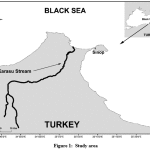 |
Figure 1: Study area Click here to View Figure |
Carp samples were caught from Karasu Stream in summer (July and August), autumn (September and October) and winter (November and December) of the year 2016. The samples were washed in bi-distilled water to remove any debris. The muscles were dissected according to Bernhard.5 These edible parts were measured for metal analysis by ICP-MS.
In order to measure of heavy metal amounts in carp muscles, digested with Suprapur® HNO3 using Milestone Systems, Start D 260 microwave for metal assay. All chemicals used in the study were of reagent grade. The metal solutions from Merck were made use of the calibrations by diluting stock solutions of 1000 mg l-1. After digestion, the heavy metal levels were operated by ICP-MS (Agilent Technologies, 7700X). Metal amounts in muscles of C. carpio were determined on wet wt. basis as µg g-1. Standard reference material DORM 2 dogfish muscle from National Research Council of Canada for elements was used to measure the reliability of the analysis. All digested edible tissues were performed triplicate for each element.
The estimated daily intake (EDI)6 depends on both the metal concentration and the amount of consumption of fish. The EDI of elements was calculated using the following equation:
![]()
Where Ef is the exposure frequency (365 days/year); Ed is the exposure duration, equivalent to mean lifespan (70 years); Fir is the fish ingestion rate (g/person/day), which was considered to be 27.4 g/person/day in Sinop,4 this value is equal to about 191.8 grams in week; Cm is the concentration of heavy metal in fish (mg kg-1 wet wt.); Wab is the average body weight (an adult body weight was noted to be 70 kg); and Ta is the mean exposure time for non-carcinogens (which is equal to Ef × Ed). EWI values were computed from EDI values. Intake estimates were stated as per unit body wt. (mg kg-1 body wt. /weekly).
Target hazard quotient (THQ),6 which is a proportion of the evaluated exposure (EDI) to the oral reference dose (RfD), is used to appraise the potential non-carcinogenic risk of the people of the sensed contaminated fish.
THQ = EDI/RfD
Where, the RfD values for Hg, Cd, Cu and Zn are 0.0003, 0.001, 0.04 and 0.3 mg/kg-day, respectively.7 RfD is not available for Pb. The U.S. Department of Health and Human Services Public Health Service8 pointed out that it would be unsuitable to develop a RfD for inorganic Pb and its compounds because some of the sanitary impacts related with exposure to Pb happen at blood Pb amounts as low as to be essentially without a threshold.9 Therefore, the RfD value for Pb in this study was 0.0035 as used by many researchers.10,11
Exposure to more than one contaminant may induce contribution and/or interactive impacts, and hereby, accumulative health effect from plural contaminants’ exposure was counted by summing THQ value of individual contaminant and clarified as total target hazard quotient (TTHQ) as follows:
TTHQ = THQ1 + THQ2 + … … … . +THQn
Where n is number of THQ values for each metal. In this study, n, which represents for number of metal, is five.
TTHQ value >1 displays the possibility of reverse health effects and commits the necessity for bearing a further appraisal and likely remedial action. However, TTHQ <1 displays no feasible health consequence from exposure of examined contaminants at existing consumption rate.
Results
Recovered values of all metals range between 98% and 105% of the certified value. In this study, C. carpio is used as a bioassay organism for sensitivity to heavy metals effects. Concentrations of heavy metals in fish samples from Karasu Stream are shown in Figures 2-6. The order of accumulation in carps is Zn>Cu>Pb>Cd>Hg. The amounts of Hg, Cd, Pb, Cu and Zn in carps were 0.022-0.036, 0.031-0,045, 0.22-0.29, 1.32-1.61 and 8.4-12.3 mg kg-1 wet wt., respectively.
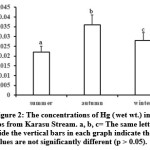 |
Figure 2: The concentrations of Hg (wet wt.) in carps from Karasu Stream. a, b, c= The same letters beside the vertical bars in each graph indicate the values are not significantly different (p > 0.05). Click here to View Figure |
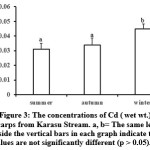 |
Figure 3: The concentrations of Cd (wet wt.) in carps from Karasu Stream. a, b= The same letters beside the vertical bars in each graph indicate the values are not significantly different (p > 0.05). Click here to View Figure |
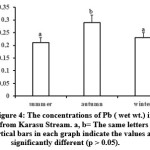 |
Figure 4: The concentrations of Pb (wet wt.) in carps from Karasu Stream. a, b= The same letters beside the vertical bars in each graph indicate the values are not significantly different (p > 0.05). Click here to View Figure |
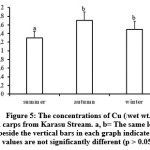 |
Figure 5: The concentrations of Cu (wet wt.) in carps from Karasu Stream. a, b= The same letters beside the vertical bars in each graph indicate the values are not significantly different (p > 0.05). Click here to View Figure |
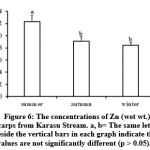 |
Figure 6: The concentrations of Zn (wet wt.) in carps from Karasu Stream. a, b= The same letters beside the vertical bars in each graph indicate the values are not significantly different (p > 0.05).Click here to View Figure |
EDIs of these metals were calculated taking into account the means of metals in edible tissues of fish samples and the mean consumption of carps per day for adults and given in Table 1.
Table 1: Estimated Daily Intakes of heavy metals (mg/day/70 kg body wt.) in edible tissues of C. carpio from the Karasu Stream.
|
EDI |
|||||
| Season |
Hg |
Cd |
Pb |
Cu |
Zn |
| Summer | 8.61143E-06 | 1.21343E-05 | 8.61143E-05 | 0.000516686 | 0.004814571 |
| Autumn | 1.40914E-05 | 1.33086E-05 | 0.000113514 | 0.0006302 | 0.000598886 |
| Winter | 0.00001096 | 1.76143E-05 | 9.39429E-05 | 0.003562 | 0.003288 |
| Mean | 1.1221E-05 | 1.43524E-05 | 9.78571E-05 | 0.000581924 | 0.00388819 |
THQ and TTHQ values of this study were shown in Table 2.
Table 2: THQ and TTHQ values in edible tissues of C. carpio from the Karasu Stream for consumers.
|
THQ |
TTHQ |
|||||
| Season |
Hg |
Cd |
Pb |
Cu |
Zn |
|
| Summer | 0.02870 | 0.01213 | 0.02460 | 0.01292 | 0.01605 | 0.09441 |
| Autumn | 0.04697 | 0.01331 | 0.03243 | 0.015755 | 0.01187 | 0.12034 |
| Winter | 0.03653 | 0.01761 | 0.02684 | 0.014972 | 0.01096 | 0.10692 |
| Mean | 0.03740 | 0.01435 | 0.02796 | 0.014548 | 0.01296 | 0.10722 |
Discussion
Hg and Cd are toxic to biota, the existing of these elements in fish may cause harm on human health at any trace levels. Similarly, Pb is also harmful to human health at even low concentrations. However, in this study (Figures 2-4), concentrations of these metals in C. carpio were lower than the safe limits (0.3 mg/kg wet wt. for Pb, 0.5 mg/kg wet wt. for Hg and 0.05 mg/kg wet wt. for Cd) proposed by EC12 and TFC.13 Cu and Zn are essential elements to biota but they make health threat when took in big amount exceeded the allowable limits by the Ministry of Agriculture, Forestry and Fisheries,14 30 mg/kg wet wt. for Cu and 50 mg/kg wet wt. for Zn. In this study (Figures 5 and 6), the amounts of Cu and Zn in the muscles of carps were lower than the maximal allowed limits. Therefore C. carpio from the Karasu Stream is healthy for consumption.
EDI values are significantly lower than the recommended values of FAO/WHO.15,16 Health risk appraisal of consumer from the consumption of carp contaminated with heavy metals was calculated by applying the THQ. If THQ < 1 express that the exposed people is unapt to experience some non-carcinogenic reverse impacts throughout the life span. If THQ > 1 express that there is a risk of non- carcinogenic effects, with a getting probability as the level rises. It can be seen from Table 2 that all metals had THQ well below 1 and overall TTHQ was 0.10722.
Consumption of C. carpio from Karasu Stream can consequently be said to create no health threats so far as the heavy metals analysed are concerned. This is set on the thought that the individual obtains all their fish supplies from the Karasu Stream and that food processing has no effects on the amounts of heavy metals available in the fish.
In this study Hg, Cd, Pb, Cu and Zn amounts in carps were 0.022-0.036, 0.031-0.045, 0.22-0.29, 1.32-1.61 and 8.4-12.3 mg kg-1 wet wt., respectively. In the literature, heavy metal levels in the muscles of carps vary considerably among different localities (Table 3). Overall Zn was detected in higher concentrations followed by Cu. The lowest were Hg and followed by Cd. The highest Hg level was 0.12±0.005 μg g−1 wet wt. in Lake Sarikum36 for carp, while similar values were found in the Lake Beyşehir21 and Altınkaya Dam Lake.34
Cd levels in for muscles of C. carpio the current study were largely in lower ranges with the literature, where it has been reported as 0.088±0.013 μg g-1 wet wt. from the Altınkaya Dam Lake17; 0.17±0.07 μg g-1 wet wt. from the Avşar Dam Lake28 and were usually in match values with the Sır Dam Lake,22 Menzelet Dam Lake,22 Lake Balık –Kızılırmak,33 Altınkaya Dam Lake,34 Lake Sarıkum36 and Sırakaraağaçlar Stream.37 As the rest of literature from Table 3 gave dry wt. values, comparisons could not be made.
Pb amounts in the literature have been found in the ranged from 0.025 μg g-1 wet wt. from Sırakaraağaçlar Stream37 to 7.04±1.93 μg g-1 dry wt. from Seyhan River.18 In general, Pb values in this study were lower than other studies17,18,19,20,23,24,26,27,28,30,31,32 and higher than those in studies.33,34,36,37 However, it should be kept in mind that some studies gave values as dry wt.
Cu amounts in the current study were in good agreement with determined amounts in the literature.17,19,20,23,26,27,31,35 Cu levels in the current study were larger than the studies.34,36,37 Similarly our data for Zn were within the ranges reported in the literature from Table 320,25,29,30,31,34; higher than those in studies.34,36,37 The values of the current study were lower than the rest of literature in Table 3.
Table 3: Comparison of the amounts of toxic metals in carps from the different locations in Turkey
| Region | Unit | Metals | Ref. | ||||
| Hg | Cd | Pb | Cu | Zn | |||
| Altınkaya Dam Lake | µg g-1 – w.w. | – | 0.088±0.013 | 0.413±0.059 | 1.04±0.116 | 16.98±1.28 | 17 |
| Seyhan River | µg g-1 – d.w. | – | 0.93±0.27 | 7.04±1.93 | 5.12±2.37 | – | 18 |
| Sakarya River | µg g-1 – d.w. | – | 0.039-0.301 | 0.056-1.094 | 0.511-2.054 | – | 19 |
| Atatürk Dam Lake | ppm – w.w. | ND | ND | ND | 1.26-3.90 | 7.39-11.50 | 20 |
| Lake Beyşehir | µg g-1 | 0.021–0.022 | 0.500–0.585 | 0.255–0.350 | – | – | 21 |
| Sır Dam Lake | ppm – w.w. | – | 0.00-1.14 | – | 0.00-0.87 | – | 22 |
| Menzelet Dam Lake | – | 0.00-0.60 | – | 0.53-3.34 | – | ||
| Kızılırmak | µg g-1 – w.w. | – | 0.12 | 1.79 | 1.1 | 80.5 | 23 |
| Sır Dam Lake | mg kg-1 –w..w. | – | – | 0.12-0.07 | – | – | 24 |
| Lake Beyşehir | mg kg-1 – d.w. | – | – | – | BDL | 7.49±4.14 11.32±3.45 | 25 |
| Lake Hampınar | µg g-1 – d.w. | – | – | 1.3 ± 0.12 | 1.6 ± 0.14 | 32.1 ± 3.1 | 26 |
| 1.3 ± 0.12 | 1.2 ± 0.10 | 37.1 ± 3.3 | |||||
| Lake Dutluca | – | – | 1.2 ± 0.12 | 1.5 ± 0.14 | 32.9 ± 3.1 | ||
| 1.2 ± 0.12 | 1.2 ± 0.12 | 17.4 ± 1.4 | |||||
| Almus Dam Lake | – | – | 1.0 ± 0.10 | 2.6 ± 0.18 | 33.6 ± 2.4 | ||
| 0.7 ± 0.07 | 1.9 ± 0.15 | 37.1 ± 3.7 | |||||
| Lake Bedirkale | µg g-1 | – | – | 1.0 ± 0.1 | 1.2 ± 0.1 | 35.1 ± 3.1 | 27 |
| 1.2 ± 0.1 | 1.4 ± 0.1 | 42.1 ± 3.3 | |||||
| Lake Boztepe | – | – | 0.8 ± 0.1 | 1.6 ± 0.2 | 18.7 ± 1.6 | ||
| 1.2 ± 0.1 | 2.1 ± 0.2 | 24.2 ± 2.3 | |||||
| Lake Belpınarı | – | – | 1.4 ± 0.1 | 1.0 ± 0.1 | 18.4 ± 1.4 | ||
| 1.8 ± 0.1 | 1.3 ± 0.1 | 38.9 ± 3.1 | |||||
| Lake Avara | – | – | 1.3 ± 0.1 | 2.8 ± 0.3 | 23.6 ± 1.1 | ||
| 2.8 ± 0.2 | 3.9 ± 0.3 | 28.5 ± 1.6 | |||||
| Lake Ataköy | – | – | 0.8 ± 0.1 | 1.3 ± 0.1 | 35.6 ± 2.4 | ||
| 1.0 ± 0.1 | 3.2 ± 0.3 | 39.1 ± 3.7 | |||||
| Lake Akın | – | – | 1.8 ± 0.1 | 1.4 ± 0.1 | 39.3 ± 3.3 | ||
| 2.1 ± 0.2 | 1.9 ± 0.2 | 48.6 ± 3.5 | |||||
| Avşar Dam Lake | mg kg-1 – w.w. | – | 0.17±0.07 | 2.14±2.09 | 3.85±2.18 | – | 28 |
| Lake Suğla | mg kg-1 – w.w. | – | – | BDL | 0.31±0.09 | 11.58±1.01 | 29 |
| 0.30±0.06 | 9.83±1.78 | ||||||
| 0.36±0.02 | 10.87±0.56 | ||||||
| Işıklı Dam Lake | µg g-1 – d.w. | – | 2.00±0.47 | 1.65±0.01 | 0.37±0.04 | 4.36±1.30 | 30 |
| Karacaören Dam Lake | – | 1.95±0.42 | 1.90±0.02 | 1.85±1.24 | 13.13±2.83 | ||
| Lake Beyşehir | mg kg-1 – d.w. | 2.06-2.32 | 1.68-4.02 | 1.09-2.68 | 9.32-15.92 | 31 | |
| Lake Mogan | µg g-1 | – | – | 3.29-6.48 | – | 17.70-45.02 | 32 |
| Lake Balık -Kızılırmak | mg kg-1 – w.w. | – | 0.03±0.002 | 0.055±0.002 | 5±1 | 33±5 | 33 |
| Altınkaya Dam Lake | mg kg-1 – w.w. | 0.033±0.001 | 0.018±0.001 | 0.037±0.002 | 0.90±0.011 | 9.85±0.33 | 34 |
| Keban Dam Lake | mg kg-1 – d.w. | – | 0.010-0.370 | – | 1.36- 2.21 | 19.07-35.85 | 35 |
| Lake Sarıkum | µg g-1 – w.w. | 0.12±0.005 | 0.023±0.004 | 0.088±0.001 | 0.5128±0.03 | 5.33±0.78 | 36 |
| Sırakaraağaçlar Stream | mg kg-1 – w.w. | – | 0.015 | 0.025 | 0.6 | 6 | 37 |
As it can be seen from different studies, the metal values in carps showed changes in different rivers, streams and lakes. Turkey is one of the countries facing fresh water pollution mainly due to untreated discharge of industrial, agricultural and domestic wastes into rivers, streams and lakes. The lack of waste water treatment plants has resulted in discharge of polluted wastes to the rivers, streams and lakes. Little is known about the heavy metal loads in the surface water and contamination as well as toxic effects in fish residing Karasu Stream. In this study, metal amounts in carps were found for the first time in Karasu Creek.
Conclusion
Fish living in contaminated waters tend to accumulate heavy metals in their tissues. Carp is one of the most caught and consumed fish in the world, and it is a good biomonitor for determine the impacts of different contaminants on aquatic habitats. The current study was performed to determine heavy metals in the muscles of carps from Karasu Stream of Sinop Provincial. The results suggested that the studied metals are in permissible limits and their use is allowed for consumers. Estimated TTHQ of all the considered elements were below the value of 1, thus these elements in fish samples do not toxic any apparent risk to the population and carps from the Karasu Stream are healthy for consumption.
The frequent presence of heavy metals in industrial wastes and considerable bioaccumulation in freshwater fish especially common carps make them significant environmental concern. The fact that heavy metals are not biodegradable and have the ability to accumulate in the environment make them deleterious to the aquatic environment and consequently to humans who depend on fish as sources of food. Data on heavy metal amounts in fish is priority with regard to aquatic ecosystem health, wellbeing of aquatic wildlife and people consumption of fish. Therefore impact of heavy metal concentration and its effects on fish should be monitored occasionally to understand perfectly the effects of these contaminants on fish growth and the viable condition of population dynamics.
Funding details
This study was carried out by using the facilities of the hydrobiology laboratory of the University of Sinop, Fisheries Faculty.
Acknowledgements
This work was carried out at the University of Sinop, Fisheries Faculty, and Department of Hydrobiology.
Conflict of interests: Authors declare that there is no conflict of interest.
References
- Bat L. The Contamination Status of Heavy Metals in Fish from the Black Sea, Turkey and Potential Risks to Human Health. In: Sezgin M, Bat L, Ürkmez D, Arıcı E, Öztürk B, editors. Black Sea Marine Environment: The Turkish Shelf. Turkish Marine Research Foundation (TUDAV), Publication No: 46, Istanbul, TURKEY, 2017; 322-418.
- Bat L, Arıcı E. Chapter 5. Heavy Metal Levels in Fish, Molluscs, and Crustacea from Turkish Seas and Potential Risk of Human Health. In: Holban AM, Grumezescu AM. (Eds.) Handbook of Food Bioengineering, Volume 13, Food Quality: Balancing Health and Disease. Elsevier, Academic Press, 2018; 159-196. http://dx.doi.org/10.1016/B978-0-12-811442-1.00005-5
CrossRef - Bat L. Heavy metal pollution in the Black Sea. In: Düzgüneş E, Öztürk B, Zengin M. (Eds.). Turkish Fisheries in the Black Sea. Published by Turkish Marine Research Foundation (TUDAV), Istanbul, Turkey, 2014; 40: 71-107.
- Bat L. (2017). Pollution and fishing. In: Black Sea and Fishing Workshop Book. 13-14 October 2016, Sinop, In: Sezgin M, Şahin F, Özsandıkçı U. (Eds.) University of Sinop 13. Bilimsel Yayın. Şimal Ajans 2017; 21439: 17-54. (in Turkish)
- Bernhard M. Manual of Methods in the Aquatic Environment Research. FAO Fisheries Technical Paper FIRI/T, Food and Agriculture Organisation, 1976; 158, Rome.
- U.S. EPA (Environmental Protection Agency). Supplementary guidance for conducting health risk assessment of chemical mixtures. National Center for Environmental Assessment, Washington, DC, 2000; EPA/630/R00/002.
- U.S. Environmental Protection Agency (U.S. EPA). Integrated Risk Information System. 2018; https://www.epa.gov/risk/regional-screening-levels-rsls-generic-tables (accessed 18.04.2019).
- U.S. Department of Health and Human Services Public Health Service. Agency for Toxic Substances and Disease Registry. Toxicological profile for lead. 2007; Atlanta, Georgia. https://www.atsdr.cdc.gov/toxprofiles/tp13.pdf (accessed 18.04.2019).
- U.S. Environmental Protection Agency IRIS. Lead. U.S. Environmental Protection Agency. Washington, DC: Integrated Risk Information System, 2005; http://www.epa.gov/iris/
- Harmanescu M, Alda LM, Bordean DM, Gogoasa I, Gergen I. Heavy metals health risk assessment for population via consumption of vegetables grown in old mining area; a case study: Banat County, Romania. Chemistry Central Journal 2011; 5:64 http://journal.chemistrycentral.com/content/5/1/64
CrossRef - Khan S, Cao Q, Zheng YM, Huang YZ, Zhu YG. Health risks of heavy metals in contaminated soils and food crops irrigated with wastewater in Beijing, China. Environ Pollut, 2008; 152:686-692.
CrossRef - Commission Regulation (EC). Official Journal of the European Union. Setting maximum levels for certain contaminants in food stuffs. Commission Regulation (EC) No 1881/2006; 364: 5-24.
- TFC. Communiqué on maximum limits of contaminants in foodstuffs. Published in the Official Gazette: (in Turkish). (Notification No: 2008/26), 2008; Issue: 26879.
- MAFF (The Ministry of Agriculture, Forestry and Fisheries): Monitoring and Surveillance of Non-Radioactive Contaminants in the Aquatic Environment and Activities Regulating the Disposal Wastes at Sea, of 1993. Directorate of Fisheries research, Lowestoft, Aquatic Environment Monitoring Report, 1995; 44.
- FAO/WHO. Summary report of the seventy-third meeting of JECFA, Joint FAO/WHO Expert Committee on Food Additives, 2010; Geneva.
- FAO/WHO. Joint FAO/WHO food standards programme codex committee on contaminants in foods, Fifth Session, working document for information and use in discussions related to contaminants and toxins in the GSCTFF, The Hague, 2011; The Netherlands.
- Öztürk M, Bat L, Öztürk M. Altınkaya Barajı’nda (Samsun) Yaşayan Cyprinus carpio L., 1758 Türünün Çeşitli Organ ve Dokularındaki Bazı Ağır Metallerin Birikimi (In Turkish) II. Ulusal Biyoloji ve Çevre Kongresi 11-13 Eylül 1995. 1995; Ankara,Turkey.
- Canli M, Ay Ö, Kalay M. Levels of Heavy Metals (Cd, Pb, Cu, Cr and Ni) in Tissue of Cyprinus carpio, Barbus capitoand Chondrostoma regiumfrom the Seyhan River, Turkey. Turkish Journal of Zoology, 1998; 22(2): 149-158.
- Barlas N. A pilot study of heavy metal concentration in various environments and fishes in the upper Sakarya River Basin, Turkey. Environmental Toxicology: An International Journal, 1999; 14(3): 367-373.
CrossRef - Karadede H, Ünlü E. Concentrations of some heavy metals in water, sediment and fish species from the Atatürk Dam Lake (Euphrates), Turkey. Chemosphere, 2000; 41(9): 1371-1376.
CrossRef - Altindağ, A., & Yiğit, S. (2005). Assessment of heavy metal concentrations in the food web of lake Beyşehir, Turkey. Chemosphere, 60(4), 552-556.
CrossRef - Erdogrul, Ö., & Ates, D. A. (2006). Determination of cadmium and copper in fish samples from Sir and Menzelet dam lake Kahramanmaras, Turkey. Environmental monitoring and assessment, 117(1-3), 281.
CrossRef - Yilmaz F. Bioaccumulation of heavy metals in water, sediment, aquatic plants and tissues of Cyprinus carpio from Kizilirmak, Turkey. Fresen. Environ. Bull, 2006; 15: 362-371.
- Erdoğrul Ö, Erbilir F. Heavy metal and trace elements in various fish samples from Sır Dam Lake, Kahramanmaraş, Turkey. Environmental Monitoring and Assessment, 2007; 130(1-3): 373-379.
CrossRef - Tekin-Özan S, Kir I. Seasonal variations of heavy metals in some organs of carp (Cyprinus carpio L., 1758) from Beyşehir Lake (Turkey). Environmental monitoring and assessment, 2008; 138 (1-3): 201-206.
CrossRef - Mendil D, Uluözlü ÖD, Hasdemir E, Tüzen M, Sari H, Suicmez M. Determination of trace metal levels in seven fish species in lakes in Tokat, Turkey. Food Chemistry, 2005; 90(1-2): 175-179.
CrossRef - Mendil D, Uluözlü ÖD. Determination of trace metal levels in sediment and five fish species from lakes in Tokat, Turkey. Food Chemistry, 2007; 101(2): 739-745.
CrossRef - Öztürk M, Özözen G, Minareci O, Minareci E. Determination of heavy metals in fish, water and sediments of Avsar Dam Lake in Turkey. Journal of Environmental Health Science & Engineering, 2009; 6(2): 73-80.
- Çağlar C. Determination of heavy metals in liver, gill and muscle tissues of Phoxinellus anatolicus and Cyprinus carpio, living in Suğla Lake. MSc thesis, Konya: Selcuk University, 2010; 68 pp.
- Kalyoncu L, Kalyoncu H, Arslan G. Determination of heavy metals and metals levels in five fish species from Işıklı Dam Lake and Karacaören Dam Lake (Turkey). Environmental monitoring and assessment, 2012; 184(4): 2231-2235.
CrossRef - Özparlak H, Arslan G, Arslan E. Determination of some metal levels in muscle tissue of nine fish species from Beyşehir Lake, Turkey. Turkish Journal of Fisheries and Aquatic Sciences, 2012; 12(4): 761-770.
CrossRef - Benzer S, Arslan H, Uzel N, Gül A, Yılmaz M. Concentrations of metals in water, sediment and tissues of Cyprinus carpio L., 1758 from Mogan Lake (Turkey). Iranian Journal of Fisheries Sciences, 2013; 12(1): 45-55.
- Bat L, Arıcı E, Sezgin M, Şahin F. Heavy metal levels in the liver and muscle tissues of the four commercial fishes from Lake Balik, Kızılırmak Delta (Samsun, Turkey) Journal of Coastal Life Medicine, 2015; 3(12): 950-955.
- Bat L, Öztekin A. Heavy metal levels in muscle, livers and digestive tracts of Cyprinus carpio L., 1758 from Altınkaya Dam Lake of Samsun Province, Turkey. MARFRESH2018 (First International Marine & Freshwater Sciences Symposium), 2018; Kemer – Antalya / Turkey.
CrossRef - Caglar M, Canpolat O, Selamoglu Z. Determination of some heavy metal levels in three freshwater fish in Keban Dam Lake (Turkey) for public consumption. Iranian Journal of Fisheries Sciences, 2019; 18(1): 188-198.
- Bat L, Yardım Ö, Öztekin A, Şahin F. Bioaccumulation of metals in fish from Sarikum Lake. Aquatic Science and Technology, 2019; 7 (1): 1-7.
CrossRef - Yardım Ö, Bat L. Heavy metal concentrations in Cyprinus carpio from Sırakaraağaçlar Stream in Sinop. ICELIS, 2019; Kastamonu, Turkey.

